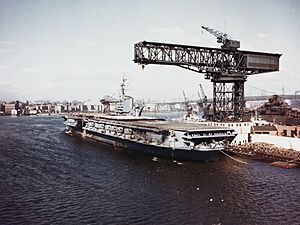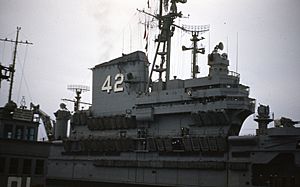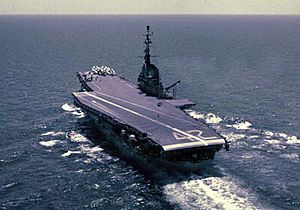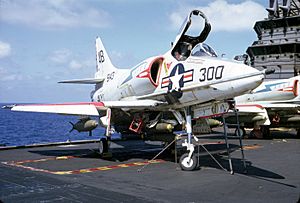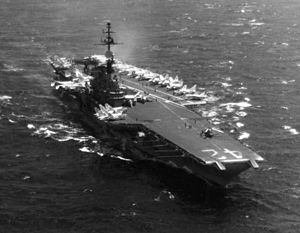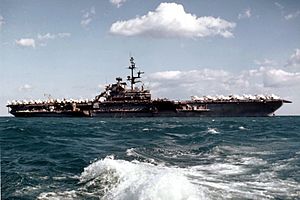USS Franklin D. Roosevelt (CV-42) facts for kids
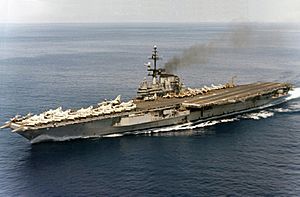
Franklin D. Roosevelt in 1967
|
|
Quick facts for kids History |
|
|---|---|
| Name | USS Franklin D. Roosevelt |
| Namesake | Franklin D. Roosevelt |
| Builder | New York Naval Shipyard |
| Laid down | 1 December 1943 |
| Launched | 29 April 1945 |
| Commissioned | 27 October 1945 |
| Decommissioned | 30 September 1977 |
| Stricken | 1 October 1977 |
| Nickname(s) |
|
| Fate | Scrapped |
| General characteristics (as built) | |
| Class and type | Midway-class aircraft carrier |
| Displacement | 45,000 tons |
| Length | 968 ft (295 m) |
| Beam | 113 ft (34 m) |
| Draft | 35 ft (11 m) |
| Speed | 33 kn (61 km/h; 38 mph) |
| Complement | 4,104 officers and men |
| Armament |
|
| Aircraft carried | 137 |
The USS Franklin D. Roosevelt (CVB/CVA/CV-42) was a huge aircraft carrier, the second of three ships in its class. Sailors often called her "Swanky Franky," "Foo-De-Roo," or "Rosie." For most of her time in service, Roosevelt sailed in the Mediterranean Sea as part of the United States Sixth Fleet. She was taken out of service in 1977 and later taken apart for scrap metal. This ship was the first aircraft carrier in the United States Navy to be named after a U.S. President.
Contents
Building and Early Missions
The Franklin D. Roosevelt was started on December 1, 1943, at the New York Naval Shipyard. She was first named Coral Sea when she was launched on April 29, 1945. However, on May 8, 1945, President Harry S. Truman decided to rename her Franklin D. Roosevelt. This was to honor President Franklin D. Roosevelt, who had passed away just four weeks earlier.
The ship officially joined the Navy on October 27, 1945. Her first captain was Apollo Soucek. During her first training trip, Roosevelt visited Rio de Janeiro, Brazil, in February 1946. She represented the United States at the inauguration of Brazil's new president. In April and May, Roosevelt took part in the Navy's first big training exercise after World War II.
A special moment happened on July 21, 1946. Roosevelt became the first American carrier to successfully launch and land an all-jet aircraft. Lieutenant Commander James Davidson flew a McDonnell FH Phantom jet from the ship. More jet tests happened in November with a Lockheed P-80 Shooting Star.
After training in the Caribbean, Roosevelt went on her first trip to the Mediterranean Sea from August to October 1946. She led a U.S. Navy force that visited Piraeus, Greece, in September. This visit showed America's support for Greece during its civil war. Thousands of people visited the ship in different ports. This was the first of many trips Roosevelt would make to the Mediterranean. It started a tradition of American aircraft carriers being present there, which later became the United States Sixth Fleet.
In July 1947, a storm damaged the ship's front (bow). She had to go to Norfolk Naval Shipyard for major repairs. During this time, some of her anti-aircraft guns were replaced.
From September 1948 to January 1949, Roosevelt had another tour of duty in the Mediterranean. In 1950, she became the first carrier to carry nuclear weapons at sea. In 1952, she joined Operation Mainbrace, a large NATO exercise in the North Atlantic. She operated with other big ships, including the carriers USS Midway and USS Wasp.
On October 1, 1952, Roosevelt was reclassified as CVA-42. In January 1954, she sailed to Puget Sound Naval Shipyard for a big upgrade. She was too large to fit through the Panama Canal, so she had to sail all the way around Cape Horn at the southern tip of South America. She arrived in March 1954 and was temporarily taken out of service for her refit.
Major Upgrades and Changes
Roosevelt was the first ship of her type to get a major reconstruction, costing $48 million. She received a new, enclosed "hurricane bow" and stronger equipment for launching and landing aircraft. Her bridge (the control center) was made bigger, and she got a new mirror landing system to help pilots land. A new angled flight deck, 482-foot (147 m) long, was added. This angled deck allowed planes to land and take off at the same time, making operations safer and faster.
Some of her anti-aircraft guns were removed to save weight. Also, the heavy armor belt around the hull was taken off. The ship became heavier, so "hull blisters" were added to the sides to help her float better. Roosevelt was put back into service on April 6, 1956.
After her upgrades, Roosevelt moved to her new homeport in Mayport, Florida. In February 1957, she tested her catapults and aircraft in cold weather. In July, she began the first of three trips with the United States Sixth Fleet in the Mediterranean. These trips included NATO exercises and often involved hosting important guests.
In 1958, the remaining 3-inch (76 mm) guns were removed. In October 1958, Roosevelt helped evacuate American citizens from Nicara, Cuba, during the Cuban Revolution.
In late 1960, Roosevelt received the first Fresnel Lens Optical Landing System (FLOLS). This system uses lights to help pilots land safely. In March 1961, the ship recorded her 100,000th aircraft landing. During a 1963 overhaul, six more 5-inch (127 mm) guns were removed.
In 1964, while in the Mediterranean, Roosevelt lost a blade from one of her giant propellers. She had to sail back to New York for repairs.
From August 1966 to January 1967, Roosevelt went on her only trip to Southeast Asia, spending 95 days supporting operations in the Vietnam War. Her aircraft included McDonnell Douglas F-4 Phantom II and Douglas A-4 Skyhawk jets. Roosevelt earned one battle star for her service in the Vietnam War.
In January 1968, famous Italian actress Virna Lisi visited Roosevelt for the ship's 22nd birthday. She even helped cook 5,000 steaks on the flight deck!
Later Years and Retirement
Roosevelt was supposed to get another big upgrade, like her sister ship Midway. However, the Midway's upgrade cost too much money. So, Roosevelt only received a smaller, less expensive refit costing $46 million. This allowed her to operate newer planes like the Grumman A-6 Intruder and LTV A-7 Corsair II.
In July 1968, Roosevelt entered Norfolk Naval Shipyard for this 11-month upgrade. The forward aircraft elevator was moved, one catapult was removed, and crew areas were updated. Two more of her remaining anti-aircraft gun turrets were also removed. She returned to sea on May 26, 1969.
From August 1969, Carrier Air Wing Six became the ship's main air wing for the next seven trips. In January 1970, Roosevelt returned to the Mediterranean for another trip with the Sixth Fleet.
During her twenty-first trip with the Sixth Fleet, Roosevelt helped during the October 1973 Yom Kippur War. She served as a "landing field" for aircraft being sent to Israel. Her group of ships also stayed ready for possible evacuation missions.
In June 1976, Roosevelt began carrying AV-8A Harrier attack aircraft. These planes are special because they can take off and land vertically (VTOL). This showed that VTOL aircraft could work alongside regular jets on an aircraft carrier. However, the hot exhaust from the Harriers damaged the flight deck's non-skid surface.
On January 12, 1977, Roosevelt had a small collision with a Liberian cargo ship called Oceanus while sailing through the Strait of Messina. Both ships were able to continue to port on their own.
Decommissioning and Scrapping
By the late 1970s, Roosevelt was getting old and was not in good condition. She hadn't received all the upgrades that her sister ships, Midway and Coral Sea, had. This made her the least modern and capable carrier of her class. Also, her engines had ongoing problems.
Because of this, the Navy decided to take Roosevelt out of service when the second Nimitz-class aircraft carrier, Dwight D. Eisenhower, was ready in 1977. Roosevelt finished her last trip in April 1977. She was officially taken out of service on September 30, 1977. Efforts to turn her into a museum ship in New York City did not succeed.
Roosevelt's poor condition meant she couldn't be kept in the Navy's reserve fleet. Also, her hangar deck was too low for many modern aircraft. On April 1, 1978, the ship was sold for $2.1 million to a company that would scrap her. After useful parts were removed, the carrier was towed to Kearny, New Jersey. She arrived on May 3, 1978, and was taken apart that year. One of her large guns, a 5”/54cal Mk.16 gun, is now on display at the White Sands Missile Range Missile Park.
Awards and Decorations
The USS Franklin D. Roosevelt and her crew earned several awards for their service:
The Sea Service Deployment Ribbon was created after the Franklin D. Roosevelt was scrapped, so she would not have officially received it.
Gallery
- USS ''Franklin D. Roosevelt'' lifecycle
-
A Buccaneer plane from the British Navy on Roosevelt in 1972.
See also
 In Spanish: USS Franklin D. Roosevelt (CV-42) para niños
In Spanish: USS Franklin D. Roosevelt (CV-42) para niños


